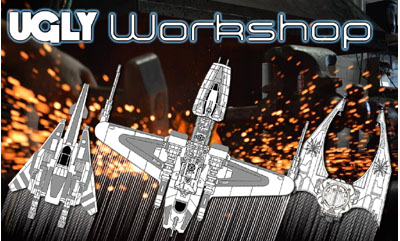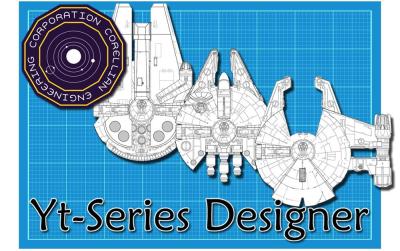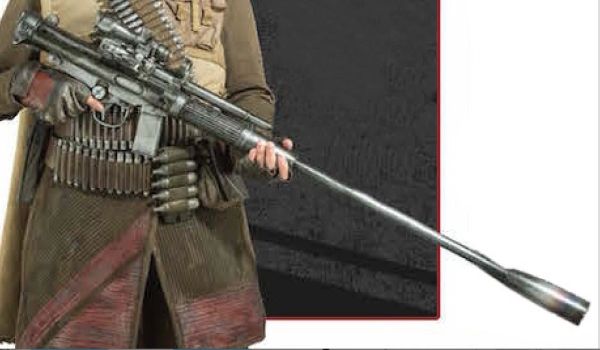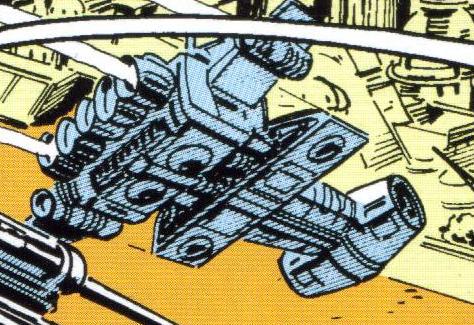 D6 MISSILES
----------------------------------------
CONTENTS
Part I: What It's About
Part II: How It Works
Part III: New Missile Rules
Part IV: Relevant Skills
Part V: Launchers and Ammunition
Part VI: Missile Types
Part VII: Modifying Missiles
Part VIII: Other Uses
----------------------------------------
PART I: WHAT IT'S ABOUT
This is an article that gives extra rules to expand the uses of missile type weapons for the WEG D6 Star Wars RPG system and any relevant games that may use these or similar rules, specifically those used by vehicles and starships. These rules are also to make missiles closer to how they work in the real world, giving players and GMs more flexibility in their use, while still retaining the base rules that all of this was started from in the D6 system.
----------------------------------------
PART II: HOW IT WORKS
In Star Wars D6, missile weapons on vehicles and starships are usually coupled with other weaponry of various kinds, such as blaster or laser cannons, and occasionally tractor beams. While the various energy weapons can engage enemies at further distances they usually have weaker damage. Missiles and other similar weapons, on the other hand, have greater damage, but a much more reduced range. Also, these missile weapons usually have no kind of blast radius, dealing damage only to the objects they hit. This has been the effects of missiles in all iterations of Star Wars RPG, even in the later D20 variations to the game.
Bombs and mines are also worth mentioning here. They usually have no range to speak of, as they are either dropped from on high in an atmosphere to hit a target below while letting gravity do all the work, or left in place in specific locations while waiting for appropriate targets to come along and trigger them, repectively. Some of the new rules below expand on how they work as well.
The rules below expand on these simple rules and give missiles more than just being a short ranged heavy attack.
----------------------------------------
PART III: NEW MISSILE RULES
-Missile Volley: Most missile launchers in Star Wars D6 are single shot affairs, only launching a single missile at a time, and sometimes these are fire-linked with other missile launchers to shoot more than one at a time to increase the damage. 'Missile volleys' are a different approach to firing multiple missiles at the same time or in rapid succession. The idea is that the person(s) using the missile weapon are attacking a single target and launching a volley of missiles at it to more effectively take it out. There are several ways to do this, however.
#1: One sure way is to simply make a missile launcher with a higher Rate of Fire. This is an easy approach, but the one using the weapon must make an attack roll for every shot in the increased fire rate, but they will not have a penalty to do so. In this, each missile is acting independently to hit the target, and with today's advanced technology, this is usually how such things would work, but it's not very simple.
#2: Another method would be to treat the missile weapon system the same way as an autofire weapon. For more details on this, please see D6 FIREARMS, also in the Supplements section. If using the Autofire rules for missile weapons, the Ammo Depletion would lose one missile for every extra +1 pip added to the damage by the skill roll. The skill being rolled would be whatever is appropriate for the weapon, usually Missile Weapons, Vehicle Weapons or Starship Gunnery. And another possibility would be the use of Autofire's "High Damage" option, where instead of the damage bonus being pips, it would full dice instead. A good middle ground for this would be +2 pips instead of +1, or perhaps giving the missiles less damage to start with if using the High Damage option (since most rapid fire missile weapons systems using smaller missiles or rockets).
#3: Yet another option for volleyfire would be to decide before making an attack roll how many missiles are being commited to the attack. Then make your attack roll as normal. The extra number of missiles would count as a +1 pip per missile for this, and that number would be a penalty for a target to Dodge, and also a bonus to Damage if they hit the target. Or, if this becomes too powerful to dodge (such as in the case of shooting hundreds of missiles at a lone target!), then for every five missiles launched at the target, the Difficulty could simply be increased by one category, starting from Very Easy. Eventually, the target (assuming something such as a starfighter pilot) would have to make a Dodge/Piloting roll that would be against the shooter's skill roll AND a Difficulty that could be as high as Heroic. If a GM wants, they could even let it go beyond Heroic, such as increasing an even five for five; Heroic +5 for every five missiles added to the volley. This option would make such a dodge truly like something out of a classic anime or similar form of media, where a fighter pilot must dodge an almost impenetrable barrier of incoming missiles, using their superb skills and a lot of luck (and character points or force points!) to make it through unscathed (relatively speaking, lol!). This option (and the 'options' with this option, lol) works very well for the purpose of volley fire, but players and GMs should choose what they feel works best for them, as always.
-Missile Barrage: A barrage of missiles is very different from how volleys work. Where volleys are multiple missiles fired at single targets, barrages are multiple missiles launched to cover an entire area in their explosive force. The idea is that a target spot is chosen for the 'ground zero' where the missiles begin impacting (or simply detonating as with space or high atmosphere having no ground). The first missile impacts at ground zero, and the rest of the barrage of missiles impacts around that point, their collective impacts spreading out from the initial missile's impact. As all of the missiles hit their target point and explode, these explosions over lap, covering an entire area with shrapnel, debris and concussive force. This makes evasion (dodging) much more difficult as these explosions overlap and even tend to get into areas that would otherwise have been excellent cover in different situations.
#1: One way to handle a missile barrage is as follows. Choose a spot for ground zero to begin the barrage (on a grid map using miniatures or similar method, simply pick a square to start from). The barrage expands from that point to the outter areas (squares, hexes, or whatever is being used, either 5ft/2m areas for character, speeder and walker scale, 1 space unit for starfighter and capital scale and up). Dodges become much harder in such a scene, because as you dodge one missile, you would be moving into another. To dodge a missile barrage, the defender must make a Dodge roll as normal (or other appropriate skill). The attacker's skill only comes into play to make the barrage hit a specific location, not the defending target being affected, and they only have to roll against a Difficulty Level (GMs discretion on what Difficulty). The defender starts their Dodge at Easy Difficulty, but this is increased by +5 (or by one Difficulty Level) for every 5ft/2m space away from him covered by the barrage. This could reach Heroic Difficulty or higher very easily, but that is the purpose of missile barrages. If the GM wants, they could cap this at Heroic and no higher, since in many cases making Heroic is an accoplishment in itself (at lower skill dice levels). In any case, the missile weapon causing the barrage loses one missile per space affected in the barrage. Missile weapons that can do barrage fire usually have an impressive amount of ammunition. Also, in case the missiles being used have an intention blast radius (see below), this would cause their damage to be exponentially amplified in a barrage, and they recieve +1D for every increase in the Dodge Difficulty as stated above.
-Bombing Run: If using bombs with flying aircraft or starships, there are ways to expand on how these are used. Bombing runs (I'll come up with a better term later. Any takers?) are for when a craft flies overhead and releases multiple bombs that collectively detonate in a (more or less) straight path. Since bombs usually have a blast radius (see below), they do not have to impact in adjacent spaces. But for all intents and purposes for the area affected by a bombing run, use the rules for the Missile Barrage above, both for damage and dodging, especially for overlapping blast radius (if this is being used, as some bombs are simply for penetrating heavily reinforced bunkers, but not always for wide-spread damage like with blast radius).
-Saturation Bombing: This is effectively just like Missile Barrage above, except it uses bombs dropped from flying craft over head, instead of missile launchers that could be deployed almost anywhere. The effects of saturation bombing are the same, with the only difference being that a vehicle is doing the bombing, which can be possibly be seen and therefor shot down.
-Range VS Speed: Most missiles in Star Wars D6 have a given range like any other weapon. BUT! What happens when it reaches the limit of their long range? Does it run out of fuel? Or explode? How did Luke Skywalker's proton torpedoes make it down that shaft to destroy the first Death Star? Are there any rules anywhere that explain this (I've never seen them)? In the case of this option, and to make missiles more like their modern real world equivalent, the missile's long range could also become its Speed. Missiles often are launched by aircraft, starfighters, bases and base ships long before their weapon carriers ever reach the target, and the missiles fly on their own for several seconds, even minutes and in some cases hours, before they hit their intended targets. For this, simply fire the missile as normal and make an attack roll. If the missile flies a full round towards a target, its long range (most missiles and proton torpedoes or other types tend to have a long range of 7) then becomes its Speed. The missile then flies this far per round towards its target . If it catches up to its target, the target must then make its Dodge roll. If the dodge is successful, the missile flies off in a random direction and does not attack again unless it is a homing missile. Note that the target could also turn around and try to outrun the missile, and if they have a higher speed, then they will do so as the missile continues to trail after them. If the missile flies for several rounds, it will continue on after its target, using the initial attack roll made by the one who launched it to determine if it hits or not. This also implies that missiles could effectively have an unlimited range. A handy option for this is that the missile could have enough fuel to fly a number of rounds equal to its Range/Speed (therefor, most missile having a Range/Speed of 7 would fly for up to seven rounds).
-Blast Radius: In Star Wars D6, grenades have a blast radius that lessens their damage by -1D per affected area, with the affected area being anywhere between three or four spaces or so. But most missiles, even the rare Tactical Fusion Missiles found in the Darkstryder Campaign, never had a blast radius. This could be seen as making them truly "tactical" weapons, where their damage is intended to only affect the target they impact upon. But this is not so for all missiles, as some are designed for tactics like fragmentation or airbursting to cause as much widespread damage as possible, especially when dealing with fighter squadrons, wings, or entire swarms of enemy craft. Nuclear weapons especially are well known for there massive blast radii (yes, that is a plural form for 'radius') that can disintegrate entire cities and even the surrounding landscape as far as the eye can see. In all cases, the effects are just like a grenade. Decide how far the blast radius is (or the increments), and for every increment away from the ground zero, the damage is -1D. In the case of missiles and nukes, though, these increments would be something like entire space units or more. Adding blast radius together with some of the other rules given above can prove highly devastating to anything they are used against!
-Mines: Unlike missiles and bombs, mines do not propel themselves, and though in some situations they could be dropped from on high, they are not designed to be effective this way. Mines are meant to be left in a specific location armed and primed, waiting for an enemy to come along and trigger the mine and cause it to detonate. The trigger could be anything from pressure studs in the mine's casing waiting to be pressed in (a good old WWII favorite), to more advanced sensors that be rigged to detect anything like motion, heat or even sound. In any case, mines are immobile, but could be deployed in a hurry by a vehicle trying to make a getaway while being chased down (Star Wars II comes to mind). Mines almost always have a blast radius to make up for their immobility to cause as much damage as possible. When mines are left behind in an area, they are usually deployed en masse. This could take the form of individual mines laid out in places that the GM knows of but the players must find the mines without detonating them and therefor avoid or disarm them, OR it could take the form of an entire area being covered in mines, similar to Missile Barrage and Saturation Bombing above, but they have not detonated yet. Players passing through such an area must make dodge/piloting rolls to pass through the area without triggering the mines. This is done by making skill rolls like mentioned above, but without the mine field having any bonuses from the collective impacts as also mentioned above. As an added bit of wicked humor, if players trip a mine, the GM could ignite the entire mine field as one explosion sets off the rest of the mines, in which it then becomes exactly like Missile Barrage above.
----------------------------------------
PART IV: RELEVANT SKILLS
The rules above are stated as being for missiles, bombs and mines, but what skills are used for these weapons and their optional effects can vary, depending on the weapon.
For character scale, it is usually Missile Weapons, though if it is built into a suit of armor and tied to the armor's systems (if powered), then Armor Weapons might be appropriate.
For speeder and walker scale, Missile Weapons can work, but different cases may use Vehicle Weapons (Blasters) might be more appropriate.
For starfighter scale, most of ships of this size use the Starship Gunnery skill, though some, such as some variants of the classic Z-95 Headhunters, use the Missile Weapons skill instead.
For capital scale, Missile Weapons might be used in some cases, but Capital Ship Gunnery would be used more often, especially if the ship (or whatever it is) is making use of advanced technologies and automation to launch its missiles.
----------------------------------------
PART V: LAUNCHERS AND AMMUNITION
While the optional rules given above make missiles more useful, there is still the case of how their launcher systems would work. In short, the launcher and missile work like a ranged weapon with an ammo capacity, much like a firearm. The launcher has a limited number of shots, and when its ordnance is spent, and can't shoot any more missiles.
Also, if using the rules above, some of those rules, such as Range/Speed and Blast Radius, only have to do with the missile, bomb or mine being used, while Missile Volley, Missile Barrage, Bombing Run and Saturation Bombing all have to do with the launchers used for deploying the ordnance. The rules that alter the launchers, for the most part, have to do with rapidly launching multiple missiles for greater affect than they would by just launching one. These launchers usually do NOT look like a tube or barrel of some sort, but more often look like a box or drum with multiple openings, hatches or closed panels waiting to fall off when used. These are usually much larger, clunky-looking and also take up much more space than normal missile launchers would when installed (this is hard to figure, GMs discretion again, but at least make it around x3-x5 what the cargo space the launcher would have needed to begin with. There are other ways of calculating the space, but this is a simple fix for going on the fly). Some launchers may only be able to fire so many missiles, limiting how much it could do in volleys or barrages, while others may be able to fire so much it would be down right impossible to dodge them (but what about outrunning them?), especially on capital scale ships, and especially again if these ships have anti-starfighter missile weapons.
Launchers could start off with any of the rules listed above but would have an increased cost (again, could be anywhere from x3 to x5 or more), and perhaps an increased ammo capacity to make use of this (see cost of appropriate missiles!). As for modifying these launchers, look below.
----------------------------------------
PART VI: MISSILE TYPES
Missiles come in many varieties, not just as bombs or mines as listed above. From common concussion missiles and proton torpedoes, tactical fusion missiles, and even many of the missile weapons found in various sections of the site (check other sections such as Equipment, as well as the Equipment category in the Starships D6 section, and perhaps in Vehicles too). All of these show different types of missiles, from ddifferent ranges, damages and even different functions such as ion damage, cluster effects, multiple warheads and many, many others.
Whatever missile types players and GMs want to use, they will almost always need a specific launcher system to use them. The idea of a catch-all missile launcher system is not too far fetched in a setting like Star Wars with its advanced and wondrous technologies, but such a thing would still cost much more in credits to obtain or build.
A quick option for using different types of missiles is making use of hardpoints to carry different kinds of ordnance, especially when needing to fill mission-specific roles in combat. There is another article elsewhere in this section that discusses pylons and hardpoints for just this purpose, and I highly recommend it for those interested.
----------------------------------------
PART VII: MODIFYING MISSILES
While adding the rules above to ordnance and their launchers can put a new twist on things, for some people this may not be enough. Everyone wants to tinker with something and make it better. In Star Wars D6, this is easy enough.
As mentioned in D6 FIREARMS elsewhere, the Star Wars RPG rulebooks (specifically the revised core rulebook and Galaxy Guide #6 Tramp Freighters) have charts that are very handy to use with Technical skills when wanting to modify items such as shields, weapons range, weapon damage, hyperdrive multiplier, and more. These can be easily adapted to alter missile weapons systems, such as increasing their ammo, range, or if the GM or players wanted to take a normal missile weapon from Star Wars RPG and add to it the optional rules as given above. Some are more or less self-explanatory, and other ideas may need some work to adapt, but it can all be done with these charts for the Tech skills.
----------------------------------------
PART VIII: OTHER USES
All of the options given here, while meant to expand on missile weapons in the game system, may have uses elsewhere for other weapons or items. Perhaps an advanced gun could be created that could use these effects. Or perhaps missiles could be kept as they are, with these effects being used for more advanced weapons of mass destruction created by highly advanced technologies people can hardly understand. Whatever the case, these options can be adapted to other weapons, items and situations. All one needs is an imagination and a good idea to start with.
|











